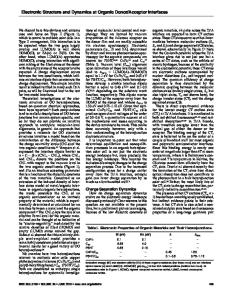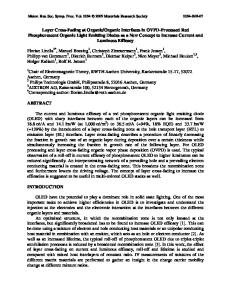Hot Exciton Dissociation at Organic Interfaces
- PDF / 3,342,602 Bytes
- 7 Pages / 612 x 792 pts (letter) Page_size
- 79 Downloads / 386 Views
Hot Exciton Dissociation at Organic Interfaces G. Grancini1, D. Fazzi1, M. Maiuri2, A. Petrozza1, H-J. Egelhaaf3, D. Brida2, G. Cerullo2 and G. Lanzani1* 1
Center for Nano Science and Technology@Polimi, Istituto Italiano di Tecnologia, via Pascoli 70/3 20133 Milano, Italy. 2 IFN-CNR, Dipartimento di Fisica, Politecnico di Milano, Piazza L. da Vinci, 32, 20133 Milano, Italy. 3 BELECTRIC OPV GmbH, Landgrabenstrasse 94, 90443 Nürnberg, Germany. ABSTRACT Interface physics is at the heart of organic photovoltaics (OPV). Here we reveal for the first time the actual charge generation mechanism in a low-band-gap polymer: fullerene blend as prototypical system for efficient OPV. We demonstrate that the photogenerated excitons dissociate into bound interfacial charge transfer states (CTS) and free charges in 20-50 fs, with a branching ratio that depends on the excess energy. Providing an excess energy, high energy singlet polymer states are excited, giving a direct hot electron transfer into the interfacial hot CTS* before internal energy dissipation occurs. This process ultimately leads to a higher fraction of free charges. Thanks to strong electronic coupling between high-energy-states and hot CTS, we demonstrate the opening of additional paths for charge generation that would otherwise be quenched by internal conversion to the lowest-lying states. Our results provide a new framework to understand charge generation in OPV system, suggesting that hot dissociation is a strategic option to enhance the photovoltaic conversion. INTRODUCTION A deep understanding of the actual charge generation processes at the base of the operation of the organic photovoltaics is a key challenge to boost the device power conversion efficiency and to set them as a real contender in the growing competitive market of green-low cost solutions for power generation [1]. By and large, charge generation is regarded as the fundamental event occurring at the donor and acceptor interface in bulk heterojunction (BHJ) solar cells following the photoexcitation of the donor material. It is widely accepted that charge generation occurs via the following path: upon light absorption the exciton singlet states is formed in the donor phase and dissociate upon encountering a D/A interface. Exciton diffusion can occur through the donor pure phase, while instantaneous exciton dissociation is expected for a finely nanometer-scale phase separated blend, consisting of high percentage of interfaces. At the interface, an electron transfer from D to A results in the formation of bound interfacial charge transfer (CT) states. Further dissociation of such interfacial states possibly due to internal electric field or due to the excess vibrational energy [1], results in separated charges that will then percolate through the respective phases and finally collected at the electrodes.
Common knowledge suggests a cold process is occurring, i.e. following absorption, excess energy with respect to the optical gap is dissipated and then local chemical potential drives the charge sep
Data Loading...











